


8 months ago
Create a hyper-realistic bird’s-eye view of a 16th-century pirate ship stranded in the middle of a flooded highway in Makassar, Indonesia. The massive ship, now very old, has tall sails that are no longer fully intact, with the wood and paint faded and weathered from time and exposure. The ship is surrounded by the floodwaters that have submerged the street, with elevated flyovers full of stopped cars due to a traffic jam caused by heavy rain. In the background, you can see the University of Makassar (UNM) campus building standing tall, and nearby, several Pinisi ships and small boats float helplessly in the rising floodwaters. The atmosphere is dramatic and chaotic, with dark clouds looming overhead, and the sky frequently pierced by lightning strikes that illuminate the scene. The rain is torrential, creating a misty fog over the city, while water ripples from the rain create an eerie reflection of the scene in the flooded streets. The contrast between the ancient pirate ship, the modern city with jammed traffic, and the presence of the Pinisi ships creates a surreal, cinematic effect. The stormy weather, the overwhelming flood, and the historical ship stranded in a modern setting evoke a sense of nature’s power and the unexpected clash of time and place.

4 months ago
"A full body, cinematic portrait of a supermodel with tousled voluminous windswept golden blonde hair in her early twenties, dressed in a figure hugging imperial red satin miniskirt, thigh high imperial red high heel boots. Soft pastel colours, featuring a swirling mist fog for a medium visibility effect. gentle and soothing light streaks, film-like composition, soft contrast, soft saturation."

8 months ago
Create a double-exposure image capturing the terrifying transformation of a werewolf mid-change, blending two intense layers: Foreground: A human figure—eyes wide with pain and primal rage—as their body twists and contorts in unnatural ways. Their skin is ripping, stretching, and growing fur, their hands elongating into clawed paws, and their mouth opening in a scream that shifts into a feral snarl. Their expression is a mix of terror, agony, and the inevitable pull of the beast within. Background: The fully transformed werewolf—a towering, monstrous creature with glowing eyes, powerful limbs, and fur bristling in the moonlight. Its snout is curled in a savage growl, and its claws glisten, ready to strike. The backdrop features a dark, misty forest under a full moon, its eerie light cutting through the swirling fog. The double exposure effect should blend the two figures together—the human dissolving into the beast, as if caught in the nightmarish in-between state of transformation. The moonlight casts an eerie glow, highlighting the tension between man and monster. The colors should be a mix of cool blues, grays, and silvers, contrasted with the deep shadows of the forest. This image should capture the horror, power, and inevitability of the werewolf’s curse, evoking both fear and fascination.
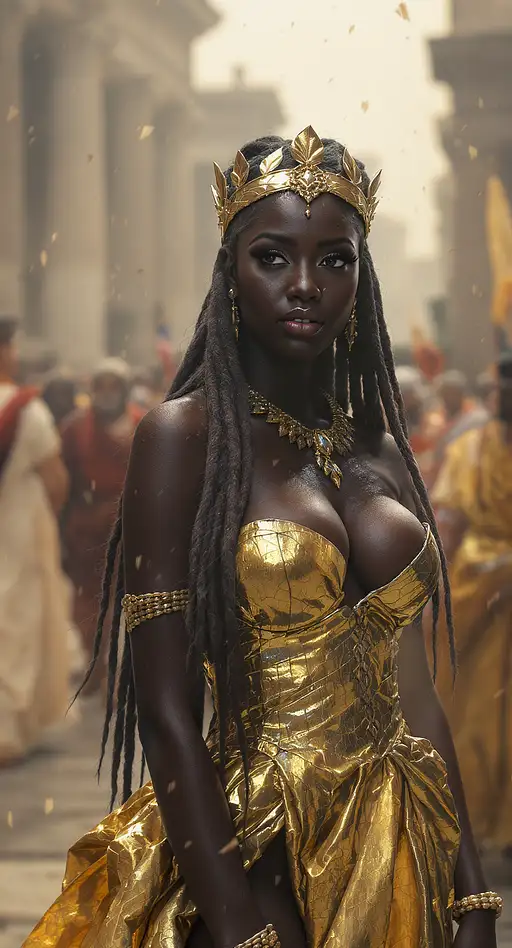
4 months ago
Bustling Ancient Roman city. A bride with long flowing dreadlock hair. She is wearing a gold dress made real, flowing gold flowers. Upon her head is a golden crown made of real gold flowers. 1. **Color Grading / Desaturation:** The image exhibits a heavily desaturated and muted color palette, primarily consisting of browns, grays, and dull greens. 2. **Contrast Enhancement (Localized/Regional):** foreground elements show good depth and texture due to contrast, while the background remains more flattened and obscured by haze. 3. **Haze/Fog Effect:** A significant atmospheric haze or fog is present, particularly in the midground and background. 4. **Vignetting (Subtle):** subtle darkening around the edges of the frame. 5. **Sharpening/Detail Enhancement:** The central figure, as well as the immediate foreground ground, show a good level of sharpness and detail. 6. **Depth of Field / Bokeh Effect:** The image uses a shallow depth of field. The main figure is in sharp focus, while the background (and all other figures or items) is significantly blurred (bokeh). 7. **Dynamic Range Compression / Shadow Enhancement:** compress of the dynamic range to enhance the moodiness and weight of the shadows. 8. **Texture Enhancement:** The textures of the clothing, hair, and personal effects are quite pronounced, employ texture clarity or enhancement filters to emphasize the overall quality of the image. 9. **Shadow Deepening:** The dark areas often appear slightly blurred or out of focus. Employ a shallow depth of field which emphasizes the well-lit subject. The darkness in the shadows is not a harsh, pure black, but rather a deep, desaturated blue-gray. 10. **Skin Wetness/Oiling Enhancement:** The most prominent effect is the amplification of the wet or oily appearance of the skin. Increase specular highlights and potentially add small white/light-colored dots or strokes to simulate water droplets or a very oily sheen. 11. **Clarity/Texture Enhancement (Skin, Subtle):** 12. **Gritty/Rough Overlay**: Apply a subtle, almost grainy or speckled overlay, particularly noticeable in the darker areas of the clothing and against the lighter background. This adds a sense of roughness and real-world grit. 13. **Weather Effects (Particles)**: The falling dust particles against the background contribute to the overall texture by introducing small, distinct elements that break up smooth areas and create a dynamic, atmospheric depth. These particles are sharp enough to be perceived individually, adding to the visual noise in a controlled way.
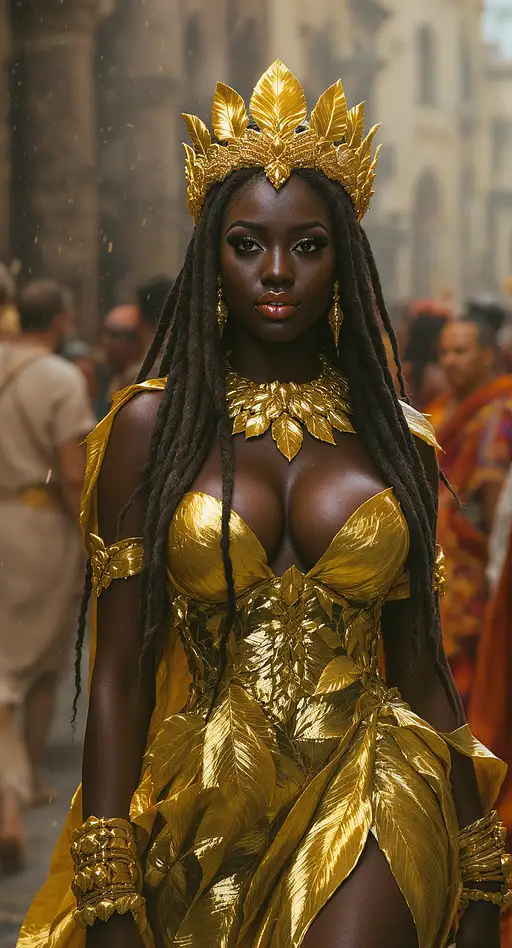
4 months ago
Bustling Ancient Roman city. A bride with long flowing dreadlock hair. She is wearing a gold dress made real, flowing gold flowers. Upon her head is a golden crown made of real gold flowers. 1. **Color Grading / Desaturation:** The image exhibits a heavily desaturated and muted color palette, primarily consisting of browns, grays, and dull greens. 2. **Contrast Enhancement (Localized/Regional):** foreground elements show good depth and texture due to contrast, while the background remains more flattened and obscured by haze. 3. **Haze/Fog Effect:** A significant atmospheric haze or fog is present, particularly in the midground and background. 4. **Vignetting (Subtle):** subtle darkening around the edges of the frame. 5. **Sharpening/Detail Enhancement:** The central figure, as well as the immediate foreground ground, show a good level of sharpness and detail. 6. **Depth of Field / Bokeh Effect:** The image uses a shallow depth of field. The main figure is in sharp focus, while the background (and all other figures or items) is significantly blurred (bokeh). 7. **Dynamic Range Compression / Shadow Enhancement:** compress of the dynamic range to enhance the moodiness and weight of the shadows. 8. **Texture Enhancement:** The textures of the clothing, hair, and personal effects are quite pronounced, employ texture clarity or enhancement filters to emphasize the overall quality of the image. 9. **Shadow Deepening:** The dark areas often appear slightly blurred or out of focus. Employ a shallow depth of field which emphasizes the well-lit subject. The darkness in the shadows is not a harsh, pure black, but rather a deep, desaturated blue-gray. 10. **Skin Wetness/Oiling Enhancement:** The most prominent effect is the amplification of the wet or oily appearance of the skin. Increase specular highlights and potentially add small white/light-colored dots or strokes to simulate water droplets or a very oily sheen. 11. **Clarity/Texture Enhancement (Skin, Subtle):** 12. **Gritty/Rough Overlay**: Apply a subtle, almost grainy or speckled overlay, particularly noticeable in the darker areas of the clothing and against the lighter background. This adds a sense of roughness and real-world grit. 13. **Weather Effects (Particles)**: The falling dust particles against the background contribute to the overall texture by introducing small, distinct elements that break up smooth areas and create a dynamic, atmospheric depth. These particles are sharp enough to be perceived individually, adding to the visual noise in a controlled way.

26 days ago
surrealism photo, x-ray, portrait, boy humanoid, upper-body, transparent skin revealing his body, glowing with a neon green bio-luminescent effect, minimalist dystopian style hoody wearing, dark ambient, darkness sci-fi moody with deep fog, futuristic cool green tone light, translucent textures, cinematic light --ar 9:16 --raw --stylize 300

9 months ago
landscape photography, Y2K Street Fashion high angle photo of a 24 year old Zulu-Ilocano female fierce martial artist with Serene calm expression. Her body is Visible ribcage with a subtle, defined curve, toned muscles, abs, small breast, flat chest. She has Oily skin with a light sheen across the forehead and nose, giving a healthy glow. The skin pores and texture are clearly visible and in focus. Low rise loose fit baggy jeans, drawstring waist detail with white rope ties, vintage denim wash, black minimalist crop top with thin straps, red paisley print bandana worn as headscarf, plain white athletic sneakers, large black leather tote bag, Y2K fashion, 90s street style, Studio smoke lighting, bright white spotlight beam cutting through fog, volumetric lighting, moody atmosphere, ray of light from above, dust particles in light beam, dramatic chiaroscuro effect, black background, theatrical lighting setup, fine mist background, minimal light setup, stark contrast, fashion editorial lighting, high-end magazine style, bright highlights and deep shadows, single source lighting, Profoto lighting setup, premium photography, sharp details in light areas, silhouette edges, modernist photography style, clean minimalist background, premium retouching, 70-200mm lens high quality fashion photography, full body shot, urban setting, professional photo, crisp details, soft shadows

9 months ago
"Create a hyper-realistic, cinematic portrait of Warwick from League of Legends in stunning 4K detail. Focus on his monstrous, wolf-like features, with every hair of his fur intricately detailed, showcasing the texture of his fur ranging from coarse and bristly on his back to smooth and sleek around his face. His glowing, bloodshot eyes should be sharp and menacing, reflecting a dangerous intensity. His elongated claws, muscular frame, and jagged, metallic arm should have visible battle scars and wear, with a gleam of rust and age. The lighting should be dramatic, with a combination of harsh highlights and deep shadows, casting striking contrasts that enhance the depth and detail of his face and body. The shading should emphasize his fierce expression and powerful build, adding a layer of realism that makes him appear alive and ready to strike. For the background, create a cinematic, moody atmosphere—perhaps a dark, mist-filled forest with sparse, dappled light filtering through twisted trees or a ruined, blood-stained battlefield. Use cinematic lighting effects to enhance the overall intensity, with rays of light cutting through fog, creating a halo effect around his menacing silhouette. The shaders should add depth, making his metallic armor appear shiny and reflective, while the fur on his neck and face should have a realistic sheen, accentuating his primal nature."

6 months ago
A hyper-realistic scene of a Porsche 911 RSR race car parked on a rain-soaked asphalt road in a misty mountain valley. The car features authentic racing decals including Mobil 1, Michelin, and Esso, with the number 92 prominently displayed. Its LED headlights are turned on, casting soft glows and reflections across the wet surface. The environment is overcast with a dramatic grey sky, rain falling softly, and a flock of birds flying in the distance. Surrounding the car are pine-covered hills partially shrouded in fog. The camera angle is low and slightly tilted for a cinematic effect, capturing water droplets, tire reflections, and the textured carbon fiber body of the car. Mood: intense, cinematic, dramatic lighting. Style: ultra-photorealistic, 8K quality, shallow depth of field.

8 months ago
Create a breathtaking and evocative double-exposure oil painting that beautifully captures the profound bond between humanity and nature, using the iconic imagery of Gorillas in the Mist. The painting should focus on the rich emotional depth of the gorillas and the lush, mist-covered landscape of the Congo, blending these elements in a way that symbolizes both the mystery of the jungle and the majesty of these endangered creatures. The central figure of the painting should be a majestic gorilla—painted with intricate detail to reflect the animal’s strength, intelligence, and vulnerability. Its face should be filled with quiet intensity, wisdom, and an almost human-like quality, conveying its deep emotional resonance. The gorilla’s eyes should be the focal point, expressive and full of emotion, perhaps suggesting the struggle for survival, a call for preservation, or an understanding of the delicate balance between nature and human interference. The double-exposure effect should allow the environment to emerge within its form, creating a stunning fusion of the animal and its misty, green habitat. The mist itself should flow through the gorilla’s body and face, creating an ethereal atmosphere that invokes the deep, mysterious quality of the jungle. Soft, translucent layers of paint should be used to capture the wisps of fog, blending into the contours of the gorilla’s powerful form. The mist should not only symbolize the natural environment but also reflect the presence of the unseen—the unseen dangers, the spiritual connection between the gorilla and the jungle, and the ongoing battle to protect these creatures from extinction. Surrounding the gorilla, the dense, vibrant foliage of the rainforest should be depicted in rich, lush greens, with hints of deep browns and subtle touches of vibrant wildflowers. Vines, leaves, and branches can emerge from the mist, merging with the gorilla’s figure, creating the sensation that it is a part of the jungle, and vice versa. The interplay of light and shadow within the leaves and the mist should evoke a sense of both serenity and mystery, with rays of sunlight filtering through the trees, casting soft, glowing highlights on the gorilla’s fur and the surrounding vegetation. The background should suggest both the wildness and fragility of the gorilla’s environment. Darker shades of green and brown can illustrate the dense canopy, while lighter, misty shades should evoke the sense of isolation and vulnerability. In the double-exposure technique, glimpses of the jungle’s wildlife—perhaps a subtle hint of a bird or a distant silhouette of another gorilla—can appear within the mist, symbolizing the delicate interconnectedness of life within the forest ecosystem. The color palette should shift between dark and light—rich earth tones that evoke the depth and complexity of the jungle, paired with the light, airy mist that suggests hope, fragility, and the need for preservation. The mist itself should be painted with fluid brushstrokes that contrast with the more textured rendering of the gorilla, creating a sense of life and motion in both the animal and its environment. This painting should not only represent the beauty and majesty of the gorillas but also serve as a powerful call for conservation. Through the double-exposure technique, it should blur the lines between the animal and its habitat, illustrating the inseparable bond between the two and the urgent need to protect these magnificent creatures from the encroaching threats of human activity. The result should be a masterpiece that blends realism with abstraction, capturing the raw, emotional beauty of the gorillas, the mystique of their environment, and the call for preservation. The viewer should feel immersed in this tranquil yet fragile world, experiencing the emotional weight of the subject matter while marveling at the intricacy and beauty of the painting itself

8 months ago
(A hyper-realistic, cinematic photograph in the style of 1970s Soviet sci-fi:1.3), depicting a lone Soviet Arctic explorer struggling through an intense blizzard (flying snow particles:1.7) as the setting sun (setting sun through blizzard:1.5) tries to pierce through the swirling storm. The explorer is clad in a bulky, worn, and weathered retro-futuristic spacesuit, with faded red and white accents and a prominently displayed CCCP insignia across the chest (CCCP insignia:1.5). His suit is covered in frost and ice, battered by the harsh Arctic conditions, with snow clinging to the edges and joints. The blizzard is fierce, with snow and ice particles violently flying through the air (flying snow particles:1.7), obscuring the landscape and making the explorer’s journey even more treacherous. The air is thick with whipping snow, which interacts with the faint light from the setting sun (sunlight piercing through storm:1.5), casting dim, golden beams that struggle to penetrate the storm. The light creates fleeting, volumetric shafts through the blizzard, catching on the swirling snowflakes and illuminating the scene in brief, ghostly flashes. Despite the fading light and harsh conditions, the explorer presses on toward a barely visible nuclear generator (nuclear generator:1.4), half-buried under the snow. His steps are slow and heavy, with snow building up around his legs as he fights against the wind. The worn spacesuit shows signs of prolonged use, with cracks in the visor fogging over, and his breath visible inside the helmet. Snow particles whip violently around him, catching the last of the day’s light, while patches of golden sunlight filter through the blizzard, giving a surreal and fleeting glow to the harsh, frozen landscape. The setting sun casts long, dramatic shadows across the snow-covered ground, but the intensity of the storm continually threatens to snuff out the light, making the environment feel overwhelming and unforgiving. The blizzard is relentless, with snow and ice clinging to the explorer’s spacesuit, and the setting sun adds a feeling of urgency, as if time is running out. The last beams of sunlight interact with the flying snow particles, creating a flickering effect, with the light constantly shifting and fading as the explorer marches forward.
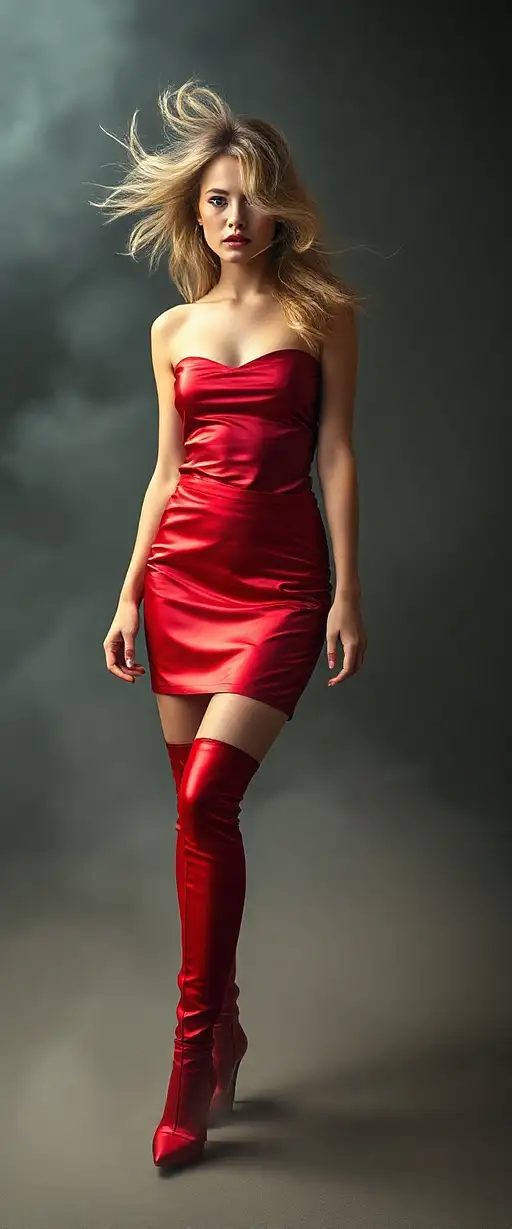
4 months ago
"A full body, cinematic portrait of a supermodel with tousled voluminous windswept golden blonde hair in her early twenties, dressed in a figure hugging imperial red satin miniskirt, thigh high imperial red high heel boots. Soft pastel colours, featuring a swirling mist fog for a medium visibility effect. gentle and soothing light streaks, film-like composition, soft contrast, soft saturation."
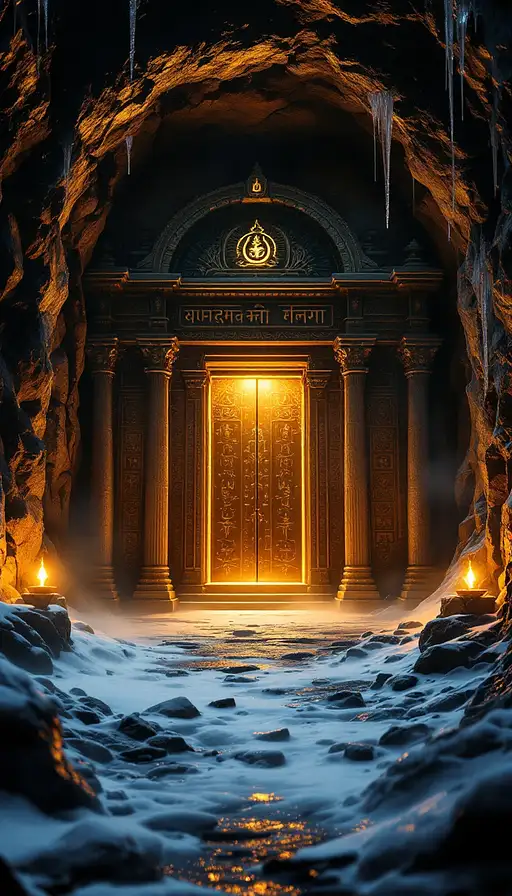
8 months ago
📌 Scene 2: Mysterious Temple Entrance in a Cave 🚪🌟 Prompt: "A hidden entrance to an ancient Shiva temple inside a deep Himalayan cave. The entrance is covered with glowing Sanskrit carvings, and large stone pillars stand on either side. The temple gate is massive and adorned with intricate depictions of Lord Shiva, tridents, and sacred symbols. Inside the cave, a warm golden light flickers from oil lamps, casting deep shadows on the rocky walls. Snow and icicles hang from the cave ceiling, while fog swirls at the ground level, adding an eerie mystical effect. Hyper-realistic, 8K resolution, cinematic lighting, volumetric light rays, dark fantasy ambiance, atmospheric depth, ultra-detailed textures, HDR rendering." 📸 Shot Type: Close-up shot, dramatic lighting, deep shadows

6 months ago
A chilling Necromancer stands amidst a fog-covered battlefield, skeletal warriors rising from the blood-soaked earth at his command. His pale, unyielding gaze burns with dark knowledge as spectral hands clutch at the shadows surrounding him. Chains of bone twist around his fingers, pulsating with forbidden magic. A crimson moon looms overhead, casting an eerie glow upon his solemn form. Dark fantasy, dramatic lighting, gothic horror, hyper-detailed spectral effects, 4K resolution

8 months ago
Design a bold and dynamic 3D text of the words 'Monster Playlist' in a gritty, neon cyberpunk style. The letters should have a metallic, futuristic texture with a mix of electric blue and deep purple neon lights glowing around them. The background should be a dark, rainy cityscape with blurred lights, creating a sense of mystery and excitement. Add subtle smoke or fog effects for depth and drama. The font should be sharp and edgy, resembling a high-energy action movie or gaming aesthetic. The overall look should be intense, modern, and eye-catching.

4 months ago
"A full body, cinematic portrait of a supermodel with tousled voluminous windswept golden blonde hair in her early twenties, dressed in a figure hugging pearl white satin miniskirt, thigh high white high heel boots. Soft pastel colours, featuring a swirling mist fog for a medium visibility effect. gentle and soothing light streaks, film-like composition, soft contrast, soft saturation."

4 months ago
Bustling Ancient Egypt city. A bride with long flowing dreadlock hair. She is wearing a gold dress made real, flowing gold flowers. Upon her head is a golden crown made of real gold flowers. 1. **Color Grading / Desaturation:** The image exhibits a heavily desaturated and muted color palette, primarily consisting of browns, grays, and dull greens. 2. **Contrast Enhancement (Localized/Regional):** foreground elements show good depth and texture due to contrast, while the background remains more flattened and obscured by haze. 3. **Haze/Fog Effect:** A significant atmospheric haze or fog is present, particularly in the midground and background. 4. **Vignetting (Subtle):** subtle darkening around the edges of the frame. 5. **Sharpening/Detail Enhancement:** The central figure, as well as the immediate foreground ground, show a good level of sharpness and detail. 6. **Depth of Field / Bokeh Effect:** The image uses a shallow depth of field. The main figure is in sharp focus, while the background (and all other figures or items) is significantly blurred (bokeh). 7. **Dynamic Range Compression / Shadow Enhancement:** compress of the dynamic range to enhance the moodiness and weight of the shadows. 8. **Texture Enhancement:** The textures of the clothing, hair, and personal effects are quite pronounced, employ texture clarity or enhancement filters to emphasize the overall quality of the image. 9. **Shadow Deepening:** The dark areas often appear slightly blurred or out of focus. Employ a shallow depth of field which emphasizes the well-lit subject. The darkness in the shadows is not a harsh, pure black, but rather a deep, desaturated blue-gray. 10. **Skin Wetness/Oiling Enhancement:** The most prominent effect is the amplification of the wet or oily appearance of the skin. Increase specular highlights and potentially add small white/light-colored dots or strokes to simulate water droplets or a very oily sheen. 11. **Clarity/Texture Enhancement (Skin, Subtle):** 12. **Gritty/Rough Overlay**: Apply a subtle, almost grainy or speckled overlay, particularly noticeable in the darker areas of the clothing and against the lighter background. This adds a sense of roughness and real-world grit. 13. **Weather Effects (Particles)**: The falling dust particles against the background contribute to the overall texture by introducing small, distinct elements that break up smooth areas and create a dynamic, atmospheric depth. These particles are sharp enough to be perceived individually, adding to the visual noise in a controlled way.

4 months ago
Bustling Ancient Roman city. An african bride with long flowing dreadlock hair. She is wearing a gold dress made real, flowing gold leaves. Upon her head is a golden crown made of real gold leaves. 1. **Color Grading / Desaturation:** The image exhibits a heavily desaturated and muted color palette, primarily consisting of browns, grays, and dull greens. 2. **Contrast Enhancement (Localized/Regional):** foreground elements show good depth and texture due to contrast, while the background remains more flattened and obscured by haze. 3. **Haze/Fog Effect:** A significant atmospheric haze or fog is present, particularly in the midground and background. 4. **Vignetting (Subtle):** subtle darkening around the edges of the frame. 5. **Sharpening/Detail Enhancement:** The central figure, as well as the immediate foreground ground, show a good level of sharpness and detail. 6. **Depth of Field / Bokeh Effect:** The image uses a shallow depth of field. The main figure is in sharp focus, while the background (and all other figures or items) is significantly blurred (bokeh). 7. **Dynamic Range Compression / Shadow Enhancement:** compress of the dynamic range to enhance the moodiness and weight of the shadows. 8. **Texture Enhancement:** The textures of the clothing, hair, and personal effects are quite pronounced, employ texture clarity or enhancement filters to emphasize the overall quality of the image. 9. **Shadow Deepening:** The dark areas often appear slightly blurred or out of focus. Employ a shallow depth of field which emphasizes the well-lit subject. The darkness in the shadows is not a harsh, pure black, but rather a deep, desaturated blue-gray. 10. **Skin Wetness/Oiling Enhancement:** The most prominent effect is the amplification of the wet or oily appearance of the skin. Increase specular highlights and potentially add small white/light-colored dots or strokes to simulate water droplets or a very oily sheen. 11. **Clarity/Texture Enhancement (Skin, Subtle):** 12. **Gritty/Rough Overlay**: Apply a subtle, almost grainy or speckled overlay, particularly noticeable in the darker areas of the clothing and against the lighter background. This adds a sense of roughness and real-world grit. 13. **Weather Effects (Particles)**: The falling dust particles against the background contribute to the overall texture by introducing small, distinct elements that break up smooth areas and create a dynamic, atmospheric depth. These particles are sharp enough to be perceived individually, adding to the visual noise in a controlled way.

6 months ago
A hyper-realistic scene of a Porsche 911 RSR race car parked on a rain-soaked asphalt road in a misty mountain valley. The car features authentic racing decals including Mobil 1, Michelin, and Esso, with the number 92 prominently displayed. Its LED headlights are turned on, casting soft glows and reflections across the wet surface. The environment is overcast with a dramatic grey sky, rain falling softly, and a flock of birds flying in the distance. Surrounding the car are pine-covered hills partially shrouded in fog. The camera angle is low and slightly tilted for a cinematic effect, capturing water droplets, tire reflections, and the textured carbon fiber body of the car. Mood: intense, cinematic, dramatic lighting. Style: ultra-photorealistic, 8K quality, shallow depth of field.
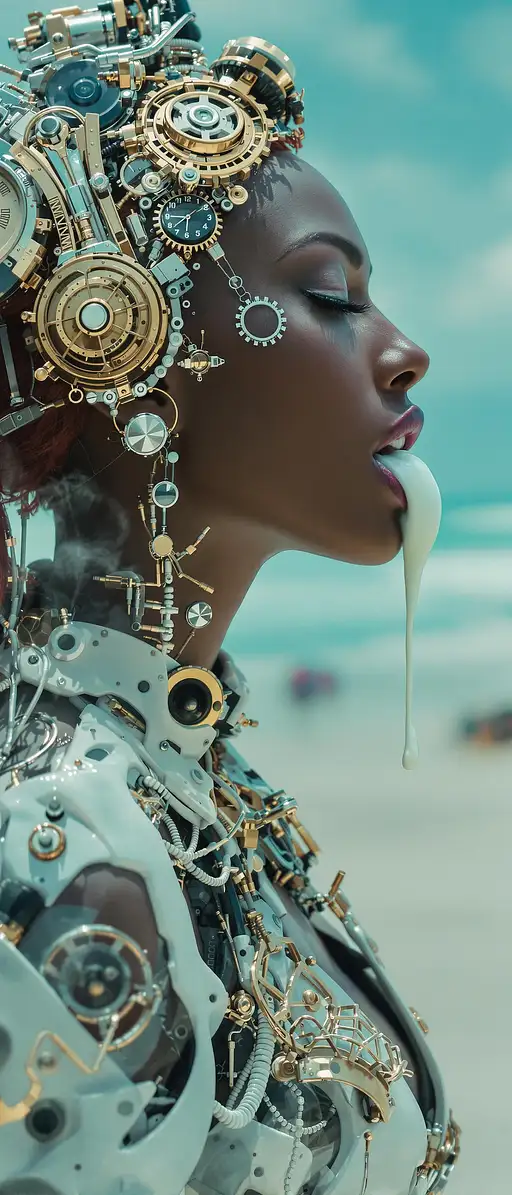
9 months ago
High resolution photography Side profile of a beautiful Redheaded, Brazilian woman with dark skin, adorned in intricate, steampunk-inspired attire, with Golds filigree and Silver accents, her eyes closed in a serene expression, her tongue playfully sticking out, as thick, white yoghurt drips from the corner of her mouth, and trickles down her chin, set against a dystopian, beachscape backdrop with white sand and blue waves, in a retro-futuristic, cyberpunk art style reminiscent of Hugh Heffner and Ron Jeremy, with a dash of 29th century flair, featuring hyper-realistic, surreal details, intricate circuitry, mechanical parts, and cybernetic enhancements, in a close-up, poster composition, with bold, blue-green tones, and contrasting, low ground effects lighting, evoking a dreamlike atmosphere, with an emphasis on high resolution, detailed texture and contrast. Smokey background fog

6 months ago
candid upper body photo of a 24 year old asian female chic minimalist with a warm and inviting expression. She has Caramel skin with a warm glow, reflecting light with a soft shimmer. She wears subtle makeup, with a hint of blush on her cheeks and a natural pink shade on her lips, the skin pores and texture are clearly visible and in focus. Her Hourglass-shaped eyes, Sparkling, jade eyes, framed by long, elegant eyelashes. Her Textured crop with shaved sides. Her eyebrows are neatly shaped, complementing her delicate facial features. cropped hoodie in a dark black with hints of purple and blue, resembling the shifting hues of spectres while revealing the midriff., midriff, Floral joggers and circular Sunglasses. She is skinny and muscular with highly toned abs. Female Bodybuilder Style. She poses Hands on a cap, head tilted sideways , rule of thirds, in the background A forest blanketed in light fog, with trees fading into the mist, their leaves glowing golden., lights Cross-filtered lights for rainbow effects the model is lighted with mood lighting in the style of Walker Evans

5 months ago
Create a hyper-realistic bird’s-eye view of a 16th-century pirate ship stranded in the middle of a flooded highway in Makassar, Indonesia. The massive ship, now very old, has tall sails that are no longer fully intact, with the wood and paint faded and weathered from time and exposure. The ship is surrounded by the floodwaters that have submerged the street, with elevated flyovers full of stopped cars due to a traffic jam caused by heavy rain. In the background, you can see the University of Makassar (UNM) campus building standing tall, and nearby, several Pinisi ships and small boats float helplessly in the rising floodwaters. The atmosphere is dramatic and chaotic, with dark clouds looming overhead, and the sky frequently pierced by lightning strikes that illuminate the scene. The rain is torrential, creating a misty fog over the city, while water ripples from the rain create an eerie reflection of the scene in the flooded streets. The contrast between the ancient pirate ship, the modern city with jammed traffic, and the presence of the Pinisi ships creates a surreal, cinematic effect. The stormy weather, the overwhelming flood, and the historical ship stranded in a modern setting evoke a sense of nature’s power and the unexpected clash of time and place.
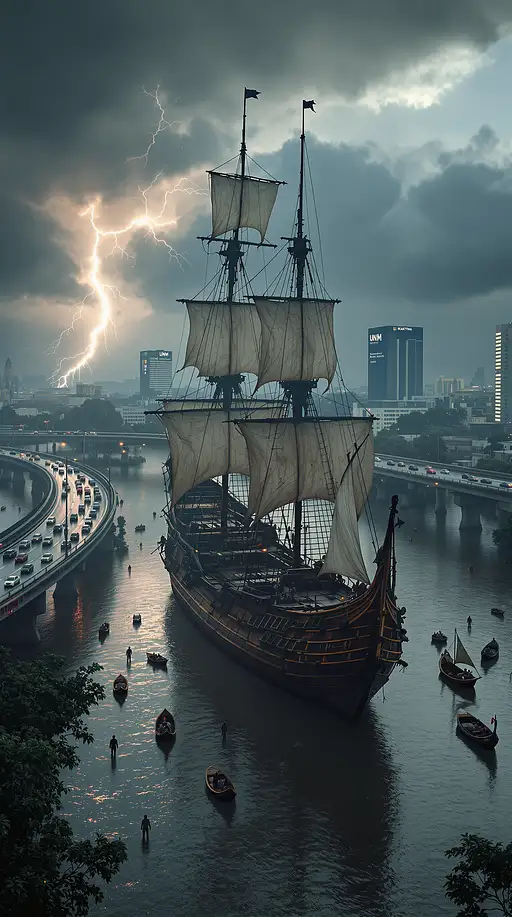
7 months ago
Create a hyper-realistic bird’s-eye view of a 16th-century pirate ship stranded in the middle of a flooded highway in Makassar, Indonesia. The massive ship, now very old, has tall sails that are no longer fully intact, with the wood and paint faded and weathered from time and exposure. The ship is surrounded by the floodwaters that have submerged the street, with elevated flyovers full of stopped cars due to a traffic jam caused by heavy rain. In the background, you can see the University of Makassar (UNM) campus building standing tall, and nearby, several Pinisi ships and small boats float helplessly in the rising floodwaters. The atmosphere is dramatic and chaotic, with dark clouds looming overhead, and the sky frequently pierced by lightning strikes that illuminate the scene. The rain is torrential, creating a misty fog over the city, while water ripples from the rain create an eerie reflection of the scene in the flooded streets. The contrast between the ancient pirate ship, the modern city with jammed traffic, and the presence of the Pinisi ships creates a surreal, cinematic effect. The stormy weather, the overwhelming flood, and the historical ship stranded in a modern setting evoke a sense of nature’s power and the unexpected clash of time and place.

